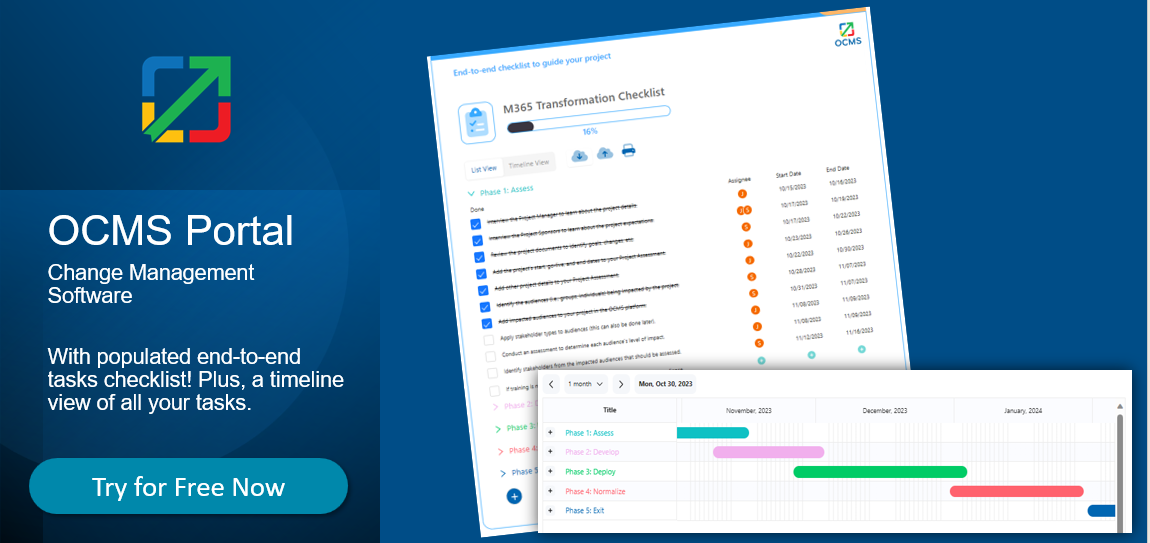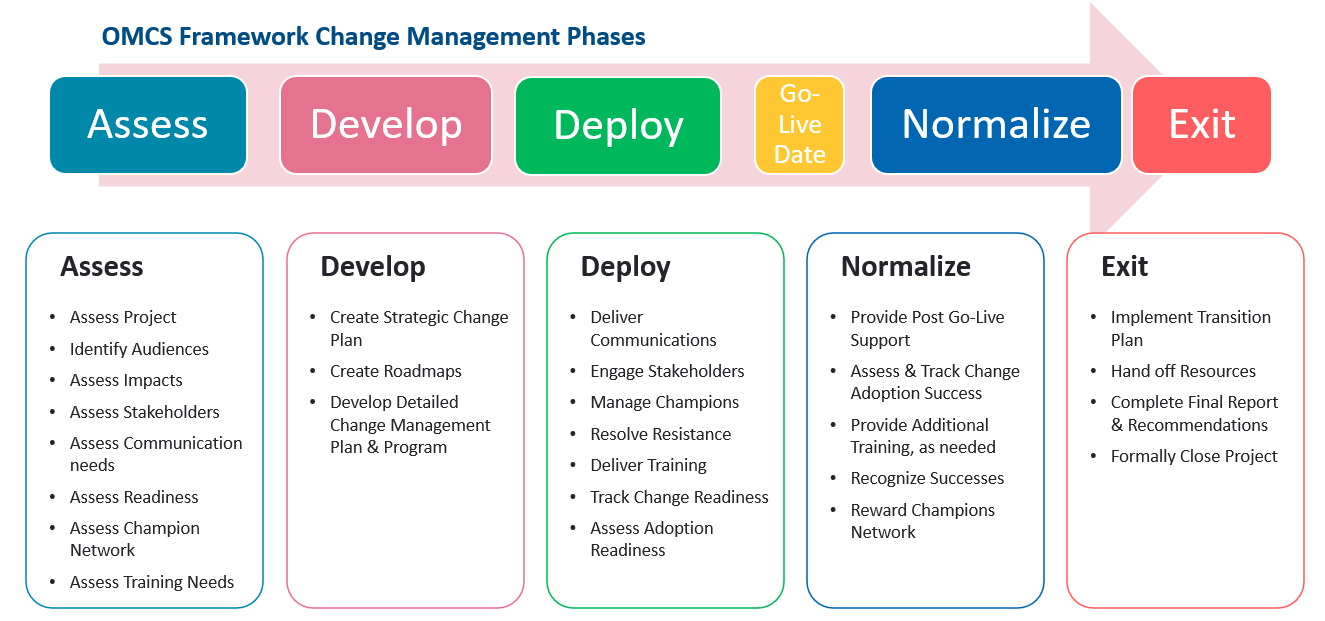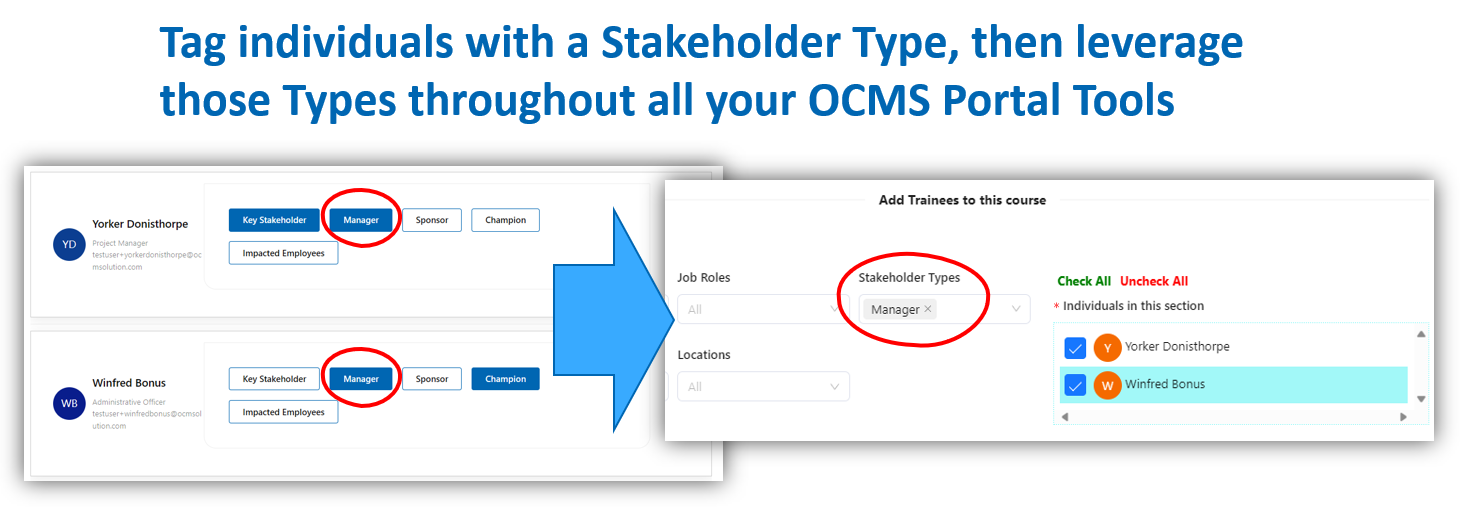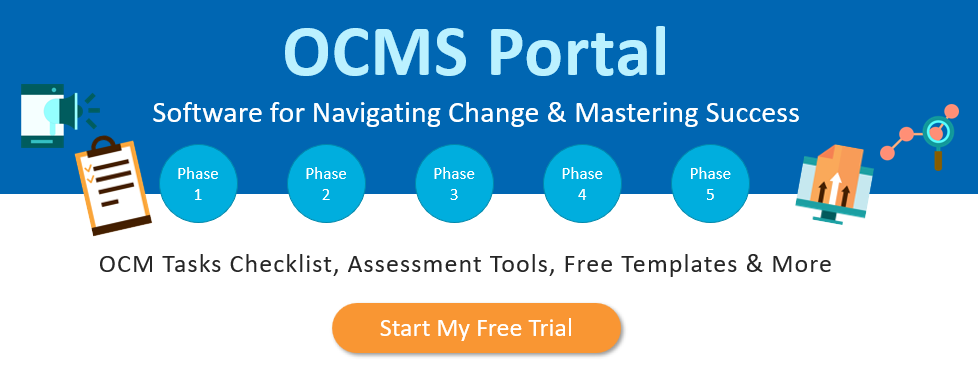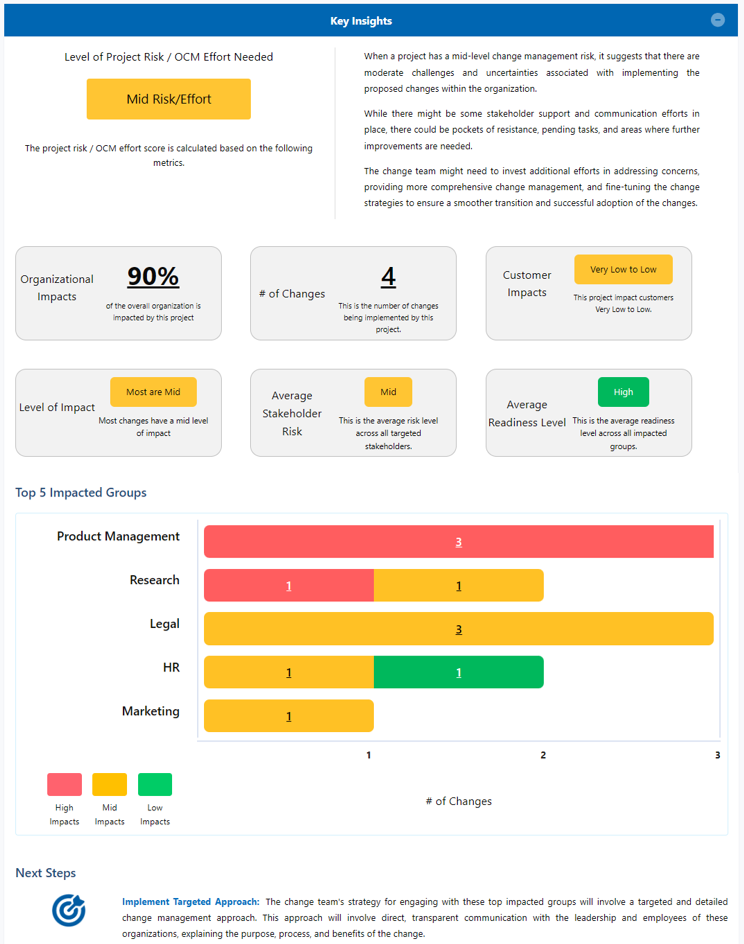Free Change Management Activities Checklist for Change Managers (Free Download)
 List of Activities for Change Management
List of Activities for Change Management
Embarking on a change management journey? We’ve got your back! Navigating through the intricate landscape of organizational transformation can be both exhilarating and challenging.
Whether you’re a seasoned Change Manager or diving into the realm of OCM for the first time, our comprehensive organizational change management checklist is your trusty guide.
From assessing your project and understanding stakeholders to celebrating those well-deserved successes, we’ve curated a helpful and practical list to ensure you don’t miss a beat.
Looking for a quick change management checklist template? Read the summary below. If you want more details, keep reading for a deeper dive into activities for change management.
Quick Summary
How Does a Change Management Plan Checklist Help?
A well-structured change management checklist serves as the compass and toolkit for any Organizational Change Management (OCM) team, offering a strategic roadmap to navigate the complex terrain of organizational transformation. By systematically outlining tasks, change management deliverables, and phases, the checklist ensures that crucial steps, from project assessment to stakeholder engagement, are not overlooked.
The change management process checklist becomes the OCM team’s go-to resource, providing a clear and comprehensive guide for implementing change management practices effectively. The checklist not only streamlines the planning and execution of tasks but also promotes collaboration within the team.
Using a shared checklist for organizational change management activities fosters a collective understanding of responsibilities, change management exercises, and timelines.
Additionally, it acts as a dynamic document, adaptable to the unique needs and scale of each change initiative. In essence, a well-crafted change management checklist template becomes the OCM team’s trusted ally, empowering them to proactively address challenges, celebrate milestones, and ultimately drive successful organizational change.
Where Does Your Change Management Checklist Come From?
The change management steps outlined below derive from the extensive expertise of OCM Solution’s senior change manager, who possesses nearly two decades of practical experience in change management. These change management exercises and tasks are also based on change management best practices and proven methods.
With a comprehensive understanding of change management fundamentals and insights into effective strategies, our approach is continually refined through customer and change community feedback. Informed by expert research from corporate training professionals, our model framework, the OCMS Change Management Framework, consists of a 5-phase change model employing a “manage by deliverables” strategy. These phases encapsulate the requisite change management activities for a successful change project, accommodating a range of project sizes and scopes.
Need a Handy Organizational Change Checklist Template & the OCM Tools to Support It? Try OCMS Portal!
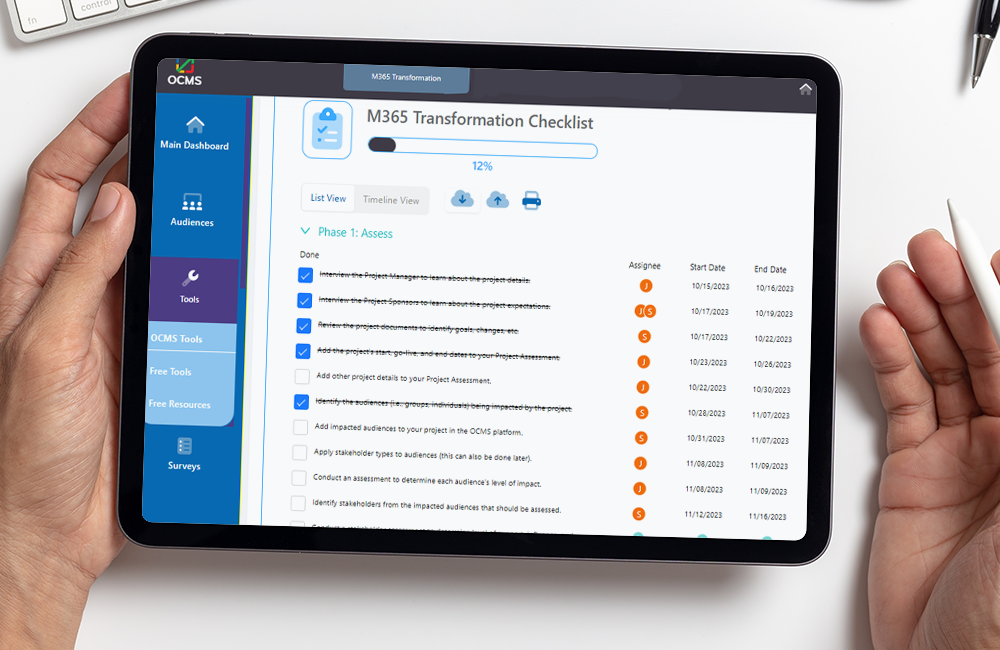
OCMS Portal is the #1 all-in-one change management software. It includes a pre-populated and customizable change management activities checklist, and all the tools you need to support a project from start to finish. Try it for free today (no card needed)!
Organizational Change Management Activities by Phase
Phases help you keep your change management activities organized and coordinated with a project timeline. Here is a quick change management process example of the types of tasks done in each OCM phase.
Phase 1 (Assess Phase):
- Focus on the assessments required upon joining a project.
- Emphasis on understanding the project and its organizational impacts.
Phase 2 (Develop Phase):
- Involves the formulation of change management plans and deliverables.
Phase 3 (Deploy Phase):
- Execution of the change management task list.
- Encompasses activities such as engagement with stakeholders, sponsors, change champions, and others through communication, meetings, training, etc.
Phase 4 (Normalize Phase):
- Includes support and follow-up change management exercises to ensure successful adoption and sustainability of the change.
- Involves success tracking and other fundamental change management practices.
Phase 5 (Exit Phase):
- Involves the hand-off of process responsibilities, such as ongoing training, to a permanent team.
- Marks the closure of the change management procedure for the project.
Get a Free Excel Change Management Activities Checklist
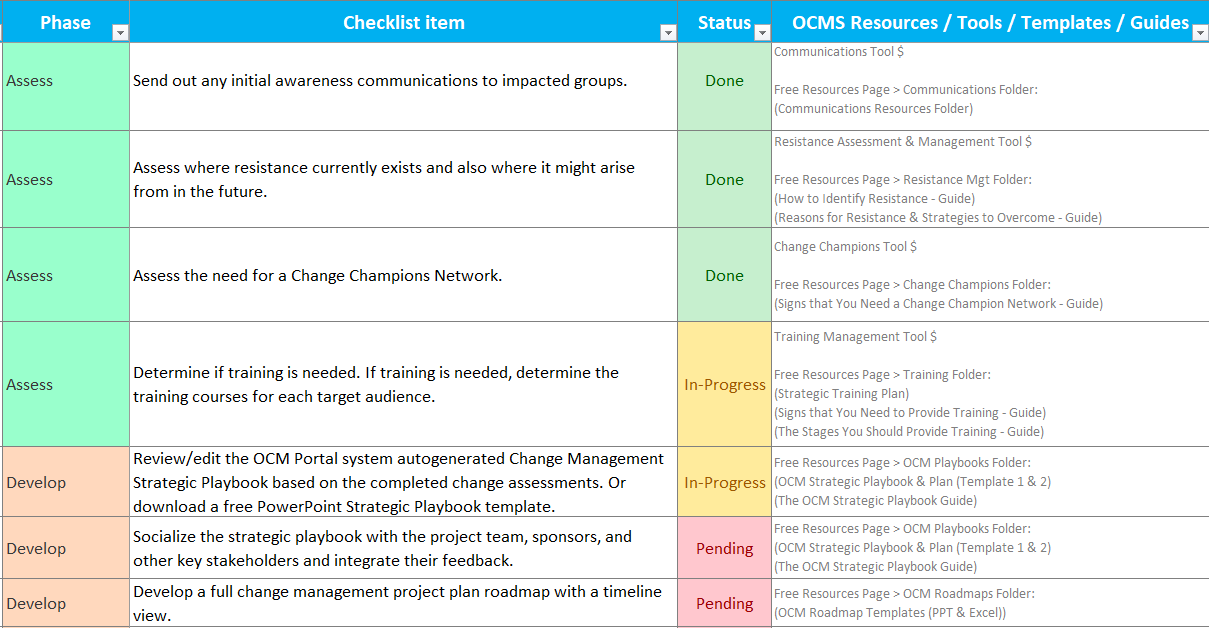
You can download this change management deliverables checklist for free, along with over 100 other OCM templates, tools, and guides. Just sign up for a free tools OCMS Portal account below. You’ll find the checklist in the Initial OCM Mgr. Tasks category.
Change Management Process Steps & Tasks
Following is an outline of a management of change checklist with some basic tasks. If you’d like to see more detail, just keep on reading past this summary section. You can also download our free organizational change management checklist.
- Choose change management approach and tools.
- Assess the project.
- Begin your change risk assessment.
- Complete a Target Audience analysis.
- Perform a change impacts assessment.
- Conduct a stakeholder analysis.
- Conduct a preliminary organizational readiness assessment.
- Assess the need for a Change Champions Network.
- Assess training & coaching needs.
- Develop a change management strategy & roadmap
- Develop Detailed OCM Plans (including communication plan, engagement plan, training plan, resistance management plan, etc.)
- Deploy the change management deliverables from the OCM Plan
- Deploy Champions Network
- Deploy communications plan
- Deploy stakeholder engagement & resistance management
- Conduct training and coaching
- Track and measure readiness and change adoption
- Resolve adoption roadblocks
- Follow-up and provide post-go-live support
- Celebrate successes
- Hand off responsibilities
- Final report & lessons learned
The completion of specific change management steps depends on factors like scale, scope, severity, and magnitude of the implemented change.
Conclusion – Change Management Steps & Tasks
The journey doesn’t conclude with the final tick on your change management activities checklist—it’s about the impact you create and the sustainable transformation you foster. As we wrap up this change management strategy summary, remember that change is a constant, and each task you’ve undertaken contributes to a ripple effect of positive evolution within your organization.
Whether you’ve smoothly navigated stakeholder engagement, addressed resistance, or celebrated those triumphant moments, your commitment to these tasks is the heartbeat of successful change management. As you move forward, carry the lessons learned, cherish the victories, and always be ready for the next wave of innovation.
Detailed Deep Dive
Top Guide for End User Engagement to Increase Change Adoption
Whether you’re a new change practitioner that’s just been assigned a change project position or have decades of experience under your belt delivering change, having a comprehensive change management checklist is essential and saves time.
One request we often receive from thousands of new change managers and project leads is, “How do we get started with our change project?” and “Do you have a change management process example checklist?”
Similar questions we hear often when giving demos of our OCMS Portal change management software are:
- Do you have a list of change management process steps?
- Where should we tell our new change agents to begin their change management activities?
- Do you have a ‘Start here’ button for change practitioners?”
- Is there a standardized list of steps to implement change in an organization?
- Where can I find a management of change checklist for my team to use?
Based on those multiple requests we have received from change managers, change consultants, and project leads, we have put together a list of change management tasks that change practitioners should complete, depending on their project.
As pioneers of best change management practices and frameworks, we believe in supporting the change management community where possible. This includes developing and offering best change practices and processes like the change management checklist template, free download, and steps to implement change provided below.
A business change can range from implementing new processes or technology integration to changing the entire culture of an organization. Irrespective of the type of change, change managers need to be familiar with the list of change management steps that may need to be completed.
Do I Need to Complete All These Change Management Tasks? No, You Don’t!
Not every business change will require you to perform all the organizational change management activities outlined below. Projects that impact a larger group of end-users or projects that are large in scope are often the ones that need most or all of the change management exercises listed below.
This change management process steps guide provides you with a holistic end-to-end view of change management tasks. However, the tasks you will need to complete will be based on the scope, scale, and severity of the change you are supporting.
Email us if you have any comments. We are change managers, and we love hearing from change practitioners and project managers. You can also contact us with questions about a change management activities PDF or cloud-based checklist of activities for change management.
Where Do These Change Management Steps Come From?
OCM Solution’s senior change manager has more than a decade and a half of change management experience. This includes a thorough understanding of change management basics as well as practical experience with what works and what doesn’t.
In addition, we are always listening to our customers and change communities and have built our products based on their feedback. Including feedback related to their ideal management of change checklist.
All this knowledge and experience, and expert research by corporate training professionals, has gone into the OCM Solution model framework for change management. The steps in the change management procedure below are based upon that OCMS Change Management Framework.
This is a 5-phase change model that uses a “manage by deliverables” approach for implementing change management. The phases categorize the change management activities that need to happen to conduct a successful change project from start to finish.
Each phase includes people-based change management deliverables which require a set of change management tasks to achieve. Our change approach allows the freedom to accomplish those deliverables in the way the change team feels is most optimized. The steps to implement change and enable business process change management are easily scalable to any size or scope of the project and can be used with both Agile and Waterfall approaches.
Change Management Steps (Holistic View)
The image below outlines the various change management tasks needed to complete a typical change project. We will discuss each of these change management process steps in the sections below. Note that these tasks are broken into five segments to match the five change management phases in the comprehensive OCM Solution change management approach.
Phase 1 (Assess Phase) includes those change management activities that you should complete when you first join a project. It is not based on when the project began. A lot of times, change practitioners are brought in when the project is already in progress. Phase 1 is focused on the assessments that you need to complete when you initially hit the ground running to learn about the project and its impacts on the organization.
Phase 2 (Develop Phase) involves the change management steps needed for developing your change management plans and deliverables.
Phase 3 (Deploy Phase) involves the execution of your change management task list. This will include things like the unfreezing stage of change, and engagement with stakeholders, sponsors, change champions, and others.
Phase 4 (Normalize Phase) includes the support and follow-up change management exercises you need to do to ensure the change is adopted and sustained successfully. This will also involve success tracking, among other change management basics.
Phase 5 (Exit Phase) involves the hand-off of process responsibilities (ongoing training, etc.) to a permanent team, and closure of the change management procedure for the project.
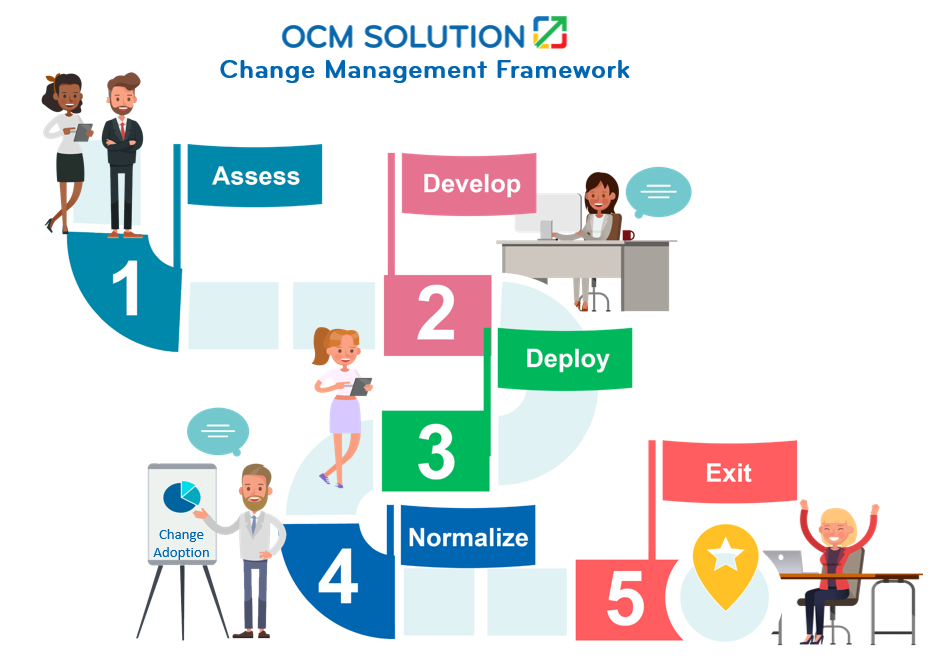
Streamline your change management process and onboarding of new OCM teammates. Check out OCMS Portal with change management tools organized by phase.
Depending on the scale, scope, severity, and magnitude of the change that is being implemented, you can determine which of these change management steps to complete on your checklist.
Checklist Change Management Steps
What are the steps for implementing change management? The end-to-end steps and tasks for an effective change program are listed below.
- Choose Change Approach & Tools
- Assess the Project/Program
- Begin a Change Risk Assessment
- Complete a Target Audience Analysis
- Perform Change Impacts’ Assessments
- Conduct Stakeholder Analysis
- Assess Resistance
- Conduct a Preliminary Organization Readiness
- Assess the Need for a Change Champions Network.
- Assess Training & Coaching Needs.
- Develop a Change Management Strategy & Roadmap
- Establish a Change Management Group (if needed)
- Develop Detailed Change Plans
- Execute Change Plans
- Deploy Change Champions/Agents Network
- Deploy Communications & Engagement Plan
- Conduct Training & Coaching
- Manage and Resolve Resistance
- Track and Measure Readiness and Change Adoption
- Resolve Adoption Roadblocks
- Follow-Up / Support Calls
- Celebrate Successes
- Hand Off Responsibilities
- Final Report & Lessons Learned
See the sections further down on this page for a more detailed overview of these steps and activities for change management.
Download a Free Change Management Process Checklist
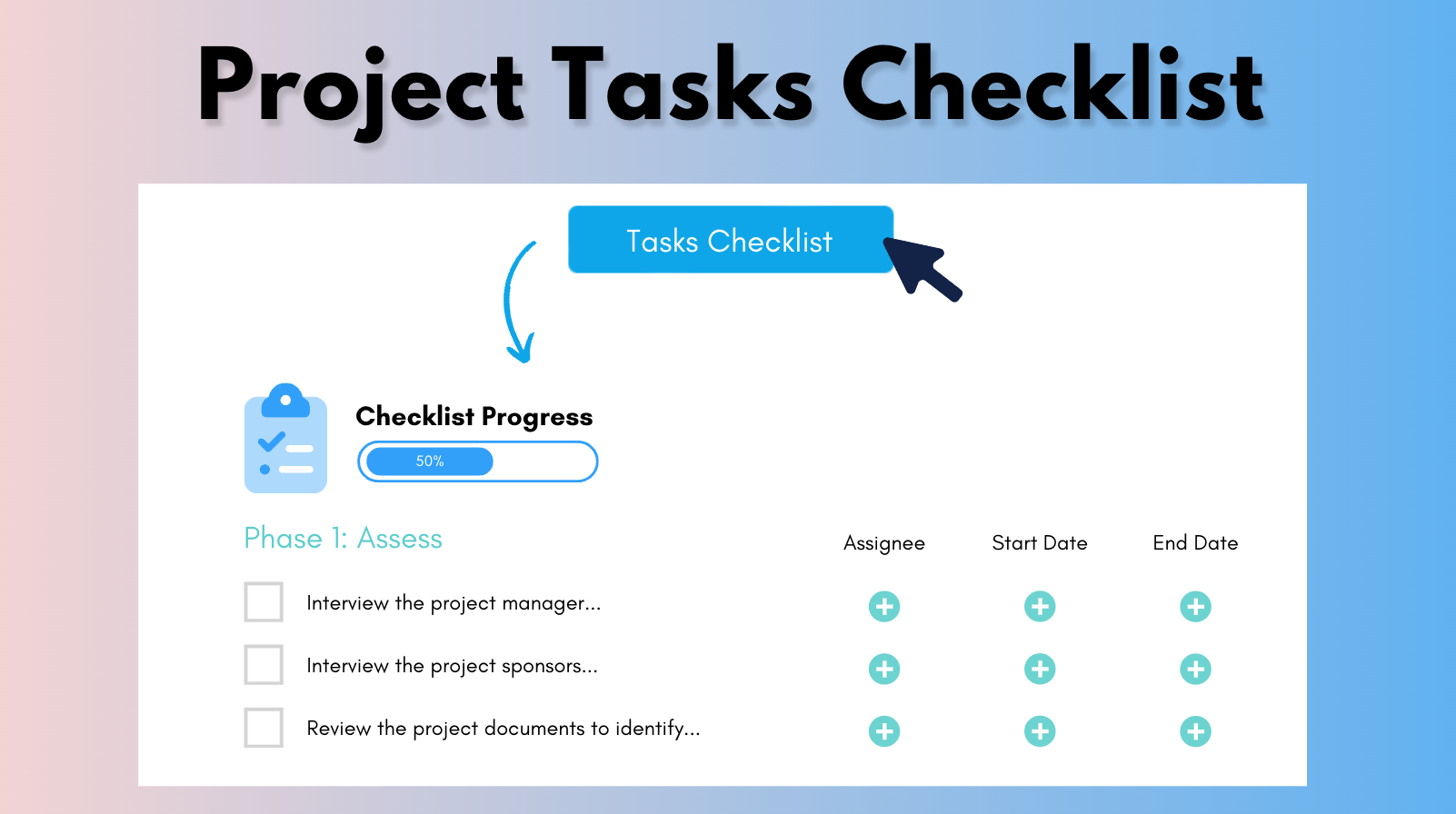
Have you been looking for a change management activities PDF or organizational change checklist? You can download one for free at OCMS. We have over 100 free templates and other resources to support change management. Sign up for a free account now for instant access.
Change Management Process Steps & Tasks
(Overview)
Next, we’ll go through an overview of change management steps and tasks. While each change initiative may differ in size and scope, these organizational change management activities give you a good idea of the process you should follow to provide OCM support for a project.
(1) Choose Change Approach & Tools
A change management approach, model, and/or framework guides you in the process of change management. Organizations will typically designate a specific approach to be used for a change project or may use a hybrid of more than one change model. You will also need to identify the software tools or spreadsheets you’ll be using to document and analyze your data.
When you create your change management strategy (aka Strategic Playbook), you’ll want to indicate which change approach is being used to govern the project and the tools you plan to use to enable the change team and keep track of your change management task list.
Read more:
- A Top Change Management Framework for Change Practitioners
- OCMS Portal – All-in-One Change Management Solution
(2) Assess the Project/Program
When you initially join a project as a Change Manager or a Project Manager, your first priority should be to conduct a thorough review of the project. The goal of conducting a project assessment is for you to understand the scope, scale, objectives, timeline, and driving factors behind the project. This knowledge enables you to rapidly ramp up and start developing and implementing your change management activities and management of change checklist.
Read more: Best Practices for Conducting a Project Assessment
(3) Begin a Change Risk Analysis
At the early stages of a project, it is essential for you to do a quick assessment of the risks that the organization will face during this change. Part of this risk assessment will involve identifying any known trouble spots or potential areas for resistance that you’ll need to address when implementing change management. As the project progresses, you should continue to evaluate risks as well as successes.
Read more: Conducting a Quick Change Risk Assessment
(4) Complete a Target Audience Analysis
Audience analysis is the process of assessing a target audience to engage with that audience and fulfill key objectives, goals, and mandates.
This process involves understanding the details of the project’s targeted audience. Whereby a change impact assessment analyzes the departments and job roles that will be impacted, the target audience assessment takes that assessment one step further by identifying the people (the “John Does” and “Jane Does”) that perform the job roles that will be impacted. As part of your assessment steps to implement change, you want to identify the names, emails, departments, contact information, geographic location (important for when it comes time to training), and other individual details.
Read more: Conducting a Target Audience Analysis
Example of a Target Audience Analysis in the OCMS Portal. You can categorize impacted individuals by stakeholder type and leverage these groupings throughout your OCM assessments and engagement.
Would you like to try OCMS Portal for free? Just sign up for a Free Trial now. (no card needed!)
(5) Perform Change Impacts’ Assessments
Conducting a change impact analysis is one of the key tasks that you need to complete as a change practitioner implementing change management. An impact assessment allows you to identify the groups, departments, functions, and job roles that will be impacted by the change. Conducting a change impact assessment will also allow you to identify the specific business processes and legacy technology tools that will be impacted (or replaced) by the change.
Read more: How to Conduct an Effective Impact Assessment + Tools & Samples
(6) Conduct Stakeholder Analysis
Understanding the stakeholders of a project is another important task that you need to complete early on. This is a very important part of an effective change management procedure as it increases the success of your stakeholder engagement and management. Stakeholder analysis involves identifying managers and business leaders that belong to impacted groups. These individuals are referred to as key stakeholders because they have a stake in the success of the business change.
Read more:
(7) Assess Resistance
Resistance assessment is a crucial component of change management, providing insight into the challenges and obstacles that may arise during the implementation of organizational changes. It involves identifying and understanding the sources and reasons behind resistance to change among employees. By conducting a thorough resistance assessment, leaders can anticipate potential roadblocks, address concerns, and develop strategies to mitigate resistance.
Read more: The Best Guide for Overcoming Employee Resistance to Change
(8) Conduct a Preliminary Organization Readiness
An organizational change readiness assessment is the set of tasks that you complete to identify how prepared an organization is for a particular change. The level of change readiness that is assessed will be based on the scale of the change itself, as well as the severity of the impacts.
When a business goes through change, the impacted audience groups need to be prepared and ready for the change. Assessing readiness includes looking at each individual’s level of awareness, acceptance, knowledge, and proficiency.
Read more: Organizational Readiness Assessment and Why You Need to Do It
(9) Assess the Need for a Change Champions Network
Assessing the need for a Change Champions Network is a crucial step in effective change management. A champions network consists of individuals within an organization who are enthusiastic about and supportive of a proposed change. These champions play a key role in advocating for the change, motivating their peers, and helping to overcome resistance.
By strategically selecting and empowering champions, organizations can create a dedicated network that acts as a driving force for change, promoting a positive and collaborative environment.
Read more: Best Change Champions and Agents Guide for Managing Champion Networks
(10) Assess Training & Coaching Needs
Assessing training and coaching needs is a critical aspect of change management, ensuring that employees are equipped with the necessary skills and support to navigate and adapt to organizational changes. This process involves identifying specific knowledge gaps, skill deficiencies, and individual or team-level challenges that may hinder the successful implementation of change initiatives.
By conducting a thorough assessment, change managers can tailor training programs and coaching strategies to address the unique requirements of employees at various levels within the organization. This may include providing technical training for new systems or offering leadership coaching to managers responsible for guiding their teams through change.
Read more:
- Benefits of Conducting Training Needs Assessments
- OCM Coaching Guide and Template to Coach Leaders for a Change
Now we’ve completed the change management process example for the Assessment Phase in the change management workflow. Do you have any questions about the organizational change management checklist up to this point? Please reach out and let us know.
(11) Develop a Change Management Strategy & Roadmap
A change management strategy (aka Strategic Playbook) needs to be developed that will provide stakeholders and leadership with an overview of the various strategies that you will be using for your change management deliverables. This strategy for business process change management includes your communications, engagement, organizational readiness, leadership engagement, training, and post-go-live deliverables.
When developing your strategy, you should also create a change management roadmap during this change management step. Ensure that you align your roadmap to the program’s implementation timeline. The roadmap is an easy way to provide the key information about the change project including deliverables, milestones, dependencies, and more.
Read more: Change Management Strategy Guide & Free Playbook
See also: Change Management Roadmaps
(12) Establish a Change Management Group
Although not mandatory, it is important for you to establish an Organizational Change Management (OCM) Working Group. Invite members of the program team (Project Managers, Program Managers, Architects, and other resources), as well as change champions and selected stakeholders, to participate in your group. This group will be your mastermind group.
In general, during change management exercises, the roles and responsibilities of the group will include:
- Participating in change management planning and execution. Reviewing and providing feedback on:
- Awareness email communications
- Communication plans and messages
- Training program and curriculum
- Go-live preparations
- Post-go-live change reinforcement activities
- Provide input on your change management tools, templates, plans, and deliverables
- Help you in conducting change impact assessments
- Help in remediating resistance
- Help in connecting Change Lead/resources with key resources, leaders, and managers
Read more: Change Management Working Groups | Everything You Need to Know
(13) Develop Detailed Change Plans
One of the larger undertakings on your change management checklist template will be the development of detailed change management plans. These include plans for several different areas of your change management activities.
- Communications Plan
- Sponsor/Leadership Enablement Plan
- Coaching Plan
- Stakeholder Engagement and Management
- Target Audience Engagement Plan
- Change Champion Networks
- Tracking and Measurement Plan
- Resistance Management Plan
- Training Plan
- Change Team Transfer/Exit Plan
OCMS Portal’s Autogenerated OCM Plan saves you hours and hours of administrative time!
Your Change Management Plan is created for you automatically in OCMS Portal based on all your change management assessments. Start a trial now and check out this #1 change management software for yourself.
(14) Execute Change Plans
This is the beginning of Phase 3 (Deploy Phase), and it’s where you’ll be taking action and executing the change management procedure and plans you developed during Phase 1 (Assess Phase). Deliver the change management plans that you put together in the sections above.
Read more: Best Change Management Planning with Step-by-Step Workflow
(15) Deploy Change Champions/Agents Network
A change champion network is a collection of selected individuals from groups that will be impacted by a change. A change champion network is a powerful part of any business process change management; it moves ownership of the change to the business units impacted by the change, which decreases end-user resistance and increases stakeholder buy-in.
Read more: Launching and Managing a Change Network
(16) Deploy Communications Plan
Push out the various communications to all groups you need to communicate with (leaders, stakeholders, sponsors, change champions, departments, etc.) according to the schedule you laid out on your change management task list.
As part of your communications plan, you should include a two-way communication strategy that involves both “Telling” and “Listening. Telling is communicating to people. Listening is hearing what these same people have to say.
Read more: The Best Communication Plan for Change Practitioners
(17) Conduct Coaching & Training
Provide the coaching that you identified during your change management process steps in Phase 1 (Assess Phase). This may include coaching for your change agents and change champions, as well as coaching for managers to help them successfully implement necessary change management basics in their departments.
Read more: The Best Coaching Plan for Coaching Managers & Employees
(18) Manage and Resolve Resistance
You’ll deploy your resistance management plan and related change management process steps which should include addressing resistance both proactively and reactively.
Read more: The Best Guide for Managing Resistance to Change
(19) Track and Measure Adoption
When it comes to tracking and measuring business process change management, including how employees, managers, or customers are adapting and transitioning through a change, there are two key areas that you need to focus on:
- Change Management Adoption & Enablement KPIs
- Change Metrics
Read more: Change Adoption Metrics & Measurement
(20) Resolve Adoption Roadblocks
After you go live, you’ll be entering the normalization phase and organizational change management activities focused on helping people release old behaviors and replace them with new ones. But people can still revert to old behaviors if you’re not actively addressing adoption roadblocks. You need to continue assessing and identifying resistance and then applying proactive and reactive mitigation plans to overcome resistance to change.
Read more: Mitigating & Resolving Roadblocks to Change Adoption
See also: Reinforcing a Change
(21) Follow-Up / Support Calls
This step in implementing change management is vital to ensuring sustained adoption of the change. It includes the following change management tasks:
- Follow up with trainees and managers to identify additional training needs
- Follow up with managers to identify post-deployment issues
- Work with necessary parties to resolve issues and roadblocks
- Conduct support calls, office hours, and post-go-live follow-up training
(22) Celebrate Successes
Celebrate quick wins and early successes:
- Constantly seek out evidence of progress in the project,
- Watch for the achievement of major milestones and identify early successes even if small.
- Organize ways to recognize groups and individuals that have achieved success. Make it public.
- Use normal staff meetings or regularly scheduled department meetings as an avenue for recognition of achievement.
- Ensure that key stakeholders are aware of these achievements and involve managers in the chain of command to award these recognitions.
(23) Hand Off Responsibilities
When a project comes to a close, the change management team will need to transition out of the project. This will be one of the last change management steps that you’ll take before closing out the project.
Part of this transition needs to involve a transfer of responsibilities from the change management team to a designated group that will be determined by the program leads. A designated group might be a group within HR, Program Management Office, or some other group.
Read more: Change Management Team Transition
(24) Final Report & Lessons Learned
One of the most helpful change management exercises you can do at the close of a project is to meet with your change management group to review how the project went and document successes, room for improvement, and other lessons learned.
This information is invaluable when planning future change management activities for new change projects in the future.
Would you like an Excel checklist with activities for change management outlined?
Then, scroll down and sign up for a free tools account with OCMS Portal. You can access a free downloadable change management process checklist (once you sign up, look in the Initial OCM Mgr Tasks category on the Free Resources page).
Sign Up to Download Your Change Management Steps & Tasks Checklist

Our Free Account is absolutely free, and no credit card is needed. It gives you access to over 100 templates, guides, and downloads, including this Excel Organizational Change Checklist.
Do you have any questions about a change management activities pdf, this change management process example, or change management exercises? Please reach out and let us know.
Activities for Change Management FAQ
What are change management steps?
Change management steps include a step-by-step list of the different tasks you need to complete to successfully deliver a change program. These steps include (1) Assess the Project/Program (2) Complete a Change Risk Analysis (3) Perform Change Impacts’ Assessments (4) Conduct Stakeholder Analysis (5) Complete a Target Audience Analysis (6) Conduct a Preliminary Organization Readiness (7) Establish a Change Management Group .. and many more
What are change management tasks?
Change management tasks are the steps you need to complete to plan, develop, deliver, and track the success of a business change program. Change tasks include five key phases: Assess, Develop, Deploy, Normalize and Exit phases.
What is a change management checklist?
A change management checklist is a list that includes change practitioner tasks and steps that need to be completed for an organizational change program to be successful
Note: Content on OCM Solution's ocmsolution.com website is protected by copyright. Should you have any questions or comments regarding this OCM Solutions page, please reach out to Ogbe Airiodion (Change Management Lead) or the OCM Solutions Team today.
External Sources: stock.adobe.com





